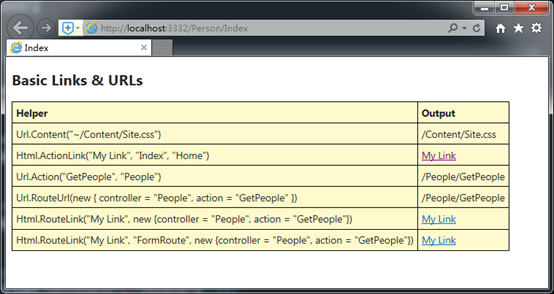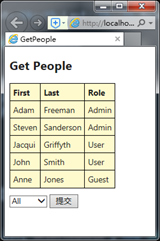创建基本的链接和URL
在我们介绍链接或URL之前先做一些准备,我们这部分要介绍的知识将要使用的项目就是之前建立的HelperMethods项目,现在需要先为其添加一个People控制器,并在其中定义一个Person模型对象的集合,具体如下:
using HelperMethods.Models; using System; using System.Collections.Generic; using System.Linq; using System.Web; using System.Web.Mvc; namespace HelperMethods.Controllers { public class PeopleController: Controller { private Person[] personData = { new Person{FirstName = "Adam",LastName = "Freeman",Role = Role.Admin}, new Person{FirstName = "Steven",LastName = "Sanderson",Role = Role.Admin}, new Person{FirstName = "Jacqui",LastName = "Griffyth",Role = Role.User}, new Person{FirstName = "John",LastName = "Smith",Role = Role.User}, new Person{FirstName = "Anne",LastName = "Jones",Role = Role.Guest} }; public ActionResult Index() { return View(); } public ActionResult GetPeople() { return View(personData); } public ActionResult GetPeople(string selectedRole) { if (selectedRole == null || selectedRole == "All") { return View(personData); } else { Role selected = (Role)Enum.Parse(typeof(Role), selectedRole); return View(personData.Where(p => p.Role == selected)); } } } }
将会使用的CSS如下(添加在/Content/Site.css,在/Views/Shared/_Layout.cshtml文件中有一个引用此文件的link元素):
… table, td, th { border: thin solid black; border-collapse: collapse; padding: 5px; background-color: lemonchiffon; text-align: left; margin: 10px 0; } div.load { color: red; margin: 10px 0; font-weight: bold; } div.ajaxLink { margin-top: 10px; margin-right: 5px; float: left; } …
创建链接或URL是视图的常见功能,它能够帮用户导航至程序的其他部分。下表总结了一些常见的HTML辅助器,大家需要知道使用这些辅助器方法生成链接和URL有个好处就是:输出来自路由配置,这意味着路由的改变会自动反映在链接和URL中。
|
描述 |
示例 |
|
相对于程序的URL |
Url.Content ("∼/Content/Site.css") 输出: /Content/Site.css |
|
链接到指定的动作/控制器 (输出链接) |
Html.ActionLink("My Link", "Index", "Home") 输出: <a href "/">My Link</a> |
|
动作URL (输出URL) |
Url.Action ("GetPeople", "People") 输出: /People/GetPeople |
|
使用路由数据的URL |
Url.RouteUrl(new {controller = "People", action = "GetPeople"}) 输出: /People/GetPeople |
|
使用路由数据的链接 |
Html.RouteLink("My Link", new {controller = "People", action = "GetPeople"}) 输出: <a href "/People/GetPeople">My Link</a> |
|
链接到指定路由 |
Html.RouteLink("My Link", "FormRoute", new {controller = "People", action = "GetPeople"}) 输出: <a href "/app/forms/People/GetPeople">My Link</a> |
后面我们创建一个视图来观察一下上述表格中的辅助器方法的使用及其效果:
@{ ViewBag.Title = "Index"; } <h2>Basic Links Á URLs</h2> <table> <thead><tr><th>Helper</th><th>Output</th></tr></thead> <tbody> <tr> <td>Url.Content("~/Content/Site.css")</td> <td>@Url.Content("~/Content/Site.css")</td> </tr> <tr> <td>Html.ActionLink("My Link", "Index", "Home")</td> <td>@Html.ActionLink("My Link", "Index", "Home")</td> </tr> <tr> <td>Url.Action("GetPeople", "People")</td> <td>@Url.Action("GetPeople", "People")</td> </tr> <tr> <td>Url.RouteUrl(new { controller = "People", action = "GetPeople" })</td> <td>@Url.RouteUrl(new { controller = "People", action = "GetPeople" })</td> </tr> <tr> <td>Html.RouteLink("My Link", new {controller = "People", action = "GetPeople"})</td> <td>@Html.RouteLink("My Link", new { controller = "People", action = "GetPeople" })</td> </tr> <tr> <td>Html.RouteLink("My Link", "FormRoute", new {controller = "People", action = "GetPeople"})</td> <td>@Html.RouteLink("My Link", "FormRoute", new { controller = "People", action = "GetPeople" })</td> </tr> </tbody> </table>
最终运行效果如:

使用MVC的渐进式Ajax
Ajax即Asynchronous JavaScript and XML(异步JavaScript与XML)的缩写。相对于其XML部分,其异步部分更为重要,且用途更广。MVC框架实现了对其支持,这也方便了我们的开发。
创建同步表单视图
下面先对GetPeople动作方法创建视图,内容如下:
@using HelperMethods.Models @model IEnumerable<Person> @{ ViewBag.Title = "GetPeople"; } <h2>Get People</h2> <table> <thead><tr><th>First</th><th>Last</th><th>Role</th></tr></thead> <tbody> @foreach (Person p in Model) { <tr> <td>@p.FirstName</td> <td>@p.LastName</td> <td>@p.Role</td> </tr> } </tbody> </table> @using (Html.BeginForm()) { <div> @Html.DropDownList("selectedRole", new SelectList(new[] { "All" }.Concat(Enum.GetNames(typeof(Role))))) <button type="submit">提交</button> </div> }
效果如下图:



这是一个HTML表单基本限制的一个简单示例,它会在提交时重载整个页面。这在真实环境中将会带来很大的代价,而且,在页面重载的时候还不能执行其他操作,我们只能等待最终展示完成。所以,也就需要一个能够异步加载的方法了,后面就来看看这一技术的使用。
为渐进式Ajax准备项目
若要使用渐进式Ajax特性的,需要在程序中两个地方配合创建。
第一:在/Web.config文件(项目根文件夹中的那个)中,configuration/appSettings元素含有一个用于UnobtrusiveJavaScriptEnabled属性的项,必须将其设置为true(MVC框架为创建新项目是默认也会是一个true值),如:
<configuration> … <appSettings> <add key="webpages:Version" value="2.0.0.0" /> <add key="webpages:Enabled" value="false" /> <add key="PreserveLoginUrl" value="true" /> <add key="ClientValidationEnabled" value="true" /> <add key="UnobtrusiveJavaScriptEnabled" value="true" /> </appSettings> … </configuration>
第二:添加对实现渐进式Ajax功能的jQuery JavaScript库的引用。我们在开发时可以在单个视图中引用该库,但更常用的一种方式是在布局文件中进行引用,以便实现在使用该布局的视图中能够通用。下面是在/Views/Shared/_Layout.cshtml文件添加了两个对JavaScript库的引用:
<!DOCTYPE html>
<html>
<head>
<meta charset="utf-8" />
<meta name="viewport" content="width=device-width" />
<title>@ViewBag.Title</title>
<link href="~/Content/Site.css" rel="stylesheet" />
<style type="text/css">
label {
display: inline-block;
width: 100px;
}
.dateElem {
margin: 5px;
}
h2 > label {
width: inherit;
}
.editor-label, .editor-field {
float: left;
}
.editor-label, .editor-label label, .editor-field input {
height: 20px;
}
.editor-label {
clear: left;
}
.editor-field {
margin-left: 10px;
margin-top: 10px;
}
input[type=submit] {
float: left;
clear: both;
margin-top: 10px;
}
.column {
float: left;
margin: 10px;
}
</style>
<script src="~/Scripts/jquery-1.8.2.min.js" type="text/javascript"></script>
<script src="~/Scripts/jquery.unobtrusive-ajax.min.js" type="text/javascript"></script>
</head>
<body>
@RenderBody()
</body>
</html>
当使用Basic模板选项创建MVC项目时,Visual Studio会将这些以script元素进行引用的文件添加到项目的Scripts文件夹中。(注意,这里添加的是min版本的js文件,这种版本是压缩版,在部署到服务器上时使用这种版本可以增加网站的加载效率,但是开发的时候建议使用普通版,这样方便阅读源代码。)
创建渐进式Ajax表单
前面已经做好了创建渐进式Ajax特性的准备,后面我们通过以等价Ajax逐步替换常规的同步表单的方式实现一个Ajax表单来了解渐进式Ajax特性的工作原理。
准备控制器
这里需要实现的是当点击提交按钮时,只有HTML的table元素中的数据被更新。因此,就需要我们首先重构People控制器中的动作方法,以便通过一个子动作仅获取想要的数据:
using HelperMethods.Models; using System; using System.Collections.Generic; using System.Linq; using System.Web; using System.Web.Mvc; namespace HelperMethods.Controllers { public class PeopleController : Controller { private Person[] personData = { new Person{FirstName = "Adam",LastName = "Freeman",Role = Role.Admin}, new Person{FirstName = "Steven",LastName = "Sanderson",Role = Role.Admin}, new Person{FirstName = "Jacqui",LastName = "Griffyth",Role = Role.User}, new Person{FirstName = "John",LastName = "Smith",Role = Role.User}, new Person{FirstName = "Anne",LastName = "Jones",Role = Role.Guest} }; public ActionResult Index() { return View(); } public PartialViewResult GetPeopleData(string selectedRole = "All") { IEnumerable<Person> data = personData; if (selectedRole != "All") { Role selected = (Role)Enum.Parse(typeof(Role), selectedRole); data = personData.Where(p => p.Role == selected); } return PartialView(data); } public ActionResult GetPeople(string selectedRole = "All") { return View((object)selectedRole); } } }
此时,我们删去了GetPeople动作方法的HttpPost版本,仅保留了一个GetPeople动作方法。并新增了GetPeopleData动作,用于选择需要显示的Person对象,并传递给PartialView方法,以便生成所需的表格行。
好了,再为GetPeopleData动作方法创建一个新的分部视图文件即可(视图文件路径:/Views/People/GetPeopleData.cshtml),该分部视图仅负责生成填充表格的tr元素:
@using HelperMethods.Models @model IEnumerable<Person> @foreach (Person p in Model) { <tr> <td>@p.FirstName</td> <td>@p.LastName</td> <td>@p.Role</td> </tr> }
更新一下/Views/People/GetPeople.cshtml视图:
@using HelperMethods.Models @model string @{ ViewBag.Title = "GetPeople"; } <h2>Get People</h2> <table> <thead><tr><th>First</th><th>Last</th><th>Role</th></tr></thead> <tbody> @Html.Action("GetPeopleData", new { selectedRole = Model }) </tbody> </table> @using (Html.BeginForm()) { <div> @Html.DropDownList("selectedRole", new SelectList(new[] { "All" }.Concat(Enum.GetNames(typeof(Role))))) <button type="submit">提交</button> </div> }
创建Ajax表单
目前虽然仍是一个同步表单,但已经在控制器中将功能分离开了,使得可以通过GetPeopleData动作只请求表格的行。
现在来看看如何使用Ajax请求这一目标动作:
@using HelperMethods.Models @model string @{ ViewBag.Title = "GetPeople"; AjaxOptions ajaxOpts = new AjaxOptions { UpdateTargetId = "tableBody" }; } <h2>Get People</h2> <table id="tableBody"> <thead><tr><th>First</th><th>Last</th><th>Role</th></tr></thead> <tbody> @Html.Action("GetPeopleData", new { selectedRole = Model }) </tbody> </table> @using (Ajax.BeginForm("GetPeopleData", ajaxOpts)) { <div> @Html.DropDownList("selectedRole", new SelectList(new[] { "All" }.Concat(Enum.GetNames(typeof(Role))))) <button type="submit">提交</button> </div> }
其实,MVC框架支持Ajax表单的核心在于Ajax.BeginForm辅助器方法,它可以接收一个AjaxOptions对象。很多人喜欢在视图开始出以Razor代码块的形式创建该对象,但如果愿意,直接在调用Ajax.BeginForm时内联地创建也并非不可。
AjaxOptions对象拥有一组常用属性,用来配置以何种形式向服务器发送异步请求,以及对取回的数据做哪些处理,下表列举了这些属性:
|
属性 |
描述 |
|
Confirm |
在形成Ajax请求之前,设置显示给用户的确认窗口中的消息 |
|
HttpMethod |
设置用来形成请求的HTTP方法——必须是GET或Post |
|
InsertionMode |
指定从服务器接受的内容以何种方式插入到HTML。有三种选择:InsertAfter、InsertBefore和Replace(默认值) |
|
LoadingElementId |
指定HTML元素的ID,这是执行Ajax请求期间要显示的HTML元素 |
|
LoadingElementDuration |
指定动画的持续时间,用于显露由LoadingElementId指定的元素 |
|
UpdateTargetId |
设置HTML元素的ID,从服务器接收的内容将被插入到该元素中 |
|
Url |
设置所请求的服务器端URL |
AjaxOptions还有一些属性,能够指定请求生命周期不同阶段的回调。后面将重点介绍。
理解渐进式Ajax的工作机制
在调用Ajax.BeginForm辅助器方法时,用AjaxOptions对象指定的选项被转换成运用于form元素的标签属性,下面是一段生成的form元素结果:
<form id="form0" action="/People/GetPeopleData" method="post" data-ajax-update="#tableBody" data-ajax-mode="replace" data-ajax="true">
…
</form>
当浏览器加载GetPeopleData.cshtml视图渲染的HTML页面时,jquery.unobtrusive-ajax.js库中的JavaScript会扫描这些HTML元素,通过考察data-ajax标签属性为true的元素,能够识别出这是一个Ajax表单。
其他以data-ajax开头的标签属性含有用AjaxOptions类指定的值。这些配置选项被用于配置jQuery,jQuery具有对Ajax请求进行管理的内建支持。
提示:并不是必须使用MVC框架的渐进式Ajax支持。还有其他办法,包括直接使用jQuery。但是,建议选用一种技术,最好坚持下去,不要在同一个视图中将MVC框架的渐进式Ajax支持与其他技术混合使用,这可能导致一些不适宜的交互影响。比如:可能会复制或丢弃Ajax请求。
设置Ajax选项
确保优雅降级
前面已经实现了Ajax的异步请求,但这么做也有一个问题,那就是如果用户禁用JavaScript(或使用不支持JavaScript的浏览器),就不能正常工作了,此时,提交表单的一个结果就是使得浏览器放弃当前的HTML页面,并用目标动作方法返回的片段代替,如下图:


我们可以通过使用AjaxOptions.Url属性,以便指定异步请求的目标URL作为Ajax.BeginForm方法的参数,而不是以动作名称作为其参数的方式解决这个问题:
@using HelperMethods.Models @model string @{ ViewBag.Title = "GetPeople"; AjaxOptions ajaxOpts = new AjaxOptions { UpdateTargetId = "tableBody", Url = Url.Action("GetPeopleData") }; } <h2>Get People</h2> <table id="tableBody"> <thead><tr><th>First</th><th>Last</th><th>Role</th></tr></thead> <tbody> @Html.Action("GetPeopleData", new { selectedRole = Model }) </tbody> </table> @using (Ajax.BeginForm(ajaxOpts)) { <div> @Html.DropDownList("selectedRole", new SelectList(new[] { "All" }.Concat(Enum.GetNames(typeof(Role))))) <button type="submit">提交</button> </div> }
通过上面的这种用法,会产生这样的效果:如果未启用JavaScript,则创建一个回递给原始动作方法的form元素,如:
<form id="form0" action="/People/GetPeople" method="post" data-ajax-url="/People/GetPeopleData" data-ajax-update="#tableBody" data-ajax-mode="replace" data-ajax="true">
…
</form>
如果启用了JavaScript,则渐进式Ajax库会以data-ajax-url标签属性为目标URL,该属性引用了子动作。如果禁用了JavaScript,则浏览器会使用常规表单的递交技术,其目标URL取自action属性,它会回递给生成完整HTML页面的动作方法。
在Ajax请求期间给用户提供反馈
由于使用Ajax进行请求时,请求的动作是在后台进行的,所以这也造成了用户无法了解正在发生的事情。但是,可以使用AjaxOptions.LoadingElementId和AjaxOptions.LoadingElementDuration属性通知用户此刻正在执行的请求。如:
@using HelperMethods.Models @model string @{ ViewBag.Title = "GetPeople"; AjaxOptions ajaxOpts = new AjaxOptions { UpdateTargetId = "tableBody", Url = Url.Action("GetPeopleData"), // 指定 HTML 元素的 ID,这是执行 Ajax 请求期间要显示的 HTML 元素 LoadingElementId = "loading", // 指定动画持续的时间,用于显露由 LoadingElementId 指定的元素 LoadingElementDuration = 1000 }; } <h2>Get People</h2> <div id="loading" class="load" style="display:none"> <p>数据加载中...</p> </div> <table id="tableBody"> <thead><tr><th>First</th><th>Last</th><th>Role</th></tr></thead> <tbody> @Html.Action("GetPeopleData", new { selectedRole = Model }) </tbody> </table> @using (Ajax.BeginForm(ajaxOpts)) { <div> @Html.DropDownList("selectedRole", new SelectList(new[] { "All" }.Concat(Enum.GetNames(typeof(Role))))) <button type="submit">提交</button> </div> }
效果如图:


… @{ ViewBag.Title = "GetPeople"; AjaxOptions ajaxOpts = new AjaxOptions { UpdateTargetId = "tableBody", Url = Url.Action("GetPeopleData"), // 指定 HTML 元素的 ID,这是执行 Ajax 请求期间要显示的 HTML 元素 LoadingElementId = "loading", // 指定动画持续的时间,用于显露由 LoadingElementId 指定的元素 LoadingElementDuration = 1000, Confirm = "Do you wish to request new data" }; } …
上面的修改补充了一个提示,它会在用户每次提交表单时显示(当然,实际项目中还是要慎重使用这一功能——它可能惹恼用户哦~):

创建Ajax链接
除了表单外,Ajax还有异步执行的a元素。它十分类似于Ajax表单的工作方式,下面是在GetPeople.cshtml视图中添加的Ajax连接:
… <div> @foreach (string role in Enum.GetNames(typeof(Role))) { <div class="ajaxLink"> @Ajax.ActionLink(role, "GetPeopleData", new { selectedRole = role }, new AjaxOptions { UpdateTargetId = "tableBody" }) </div> } </div> …
下面是这段代码产生的HTML的a元素片段:
<a href="/People/GetPeopleData?selectedRole=Admin" data-ajax-update="#tableBody" data-ajax-mode="replace" data-ajax="true">Admin</a>
注意,上面已对href进行了加粗,这是因为由于路由配置中没有selectedRole变量条目,因此,其标签属性生成的URL用查询字符串方式指定了链接所表示的角色。
下图是点击这些链接的效果:


确保链接的优雅降级
Ajax链接与Ajax表单一样,都会遇到如果浏览器不支持或禁用JavaScript时的问题,解决办法还是使用Ajax.Url属性来指定Ajax请求的URL,同时这里还要对Ajax.ActionLink辅助器方法指定GetPeople动作:
… <div> @foreach (string role in Enum.GetNames(typeof(Role))) { <div class="ajaxLink"> @Ajax.ActionLink(role, "GetPeople", new { selectedRole = role }, new AjaxOptions { UpdateTargetId = "tableBody", Url = Url.Action("GetPeopleData", new { selectedRole = role }) }) </div> } </div> …
独立的AjaxOptions能够为每个链接的Url属性指定一个不同的值,并为非JavaScript浏览器提供优雅降级支持。
使用Ajax回调
下表为AjaxOptions中定义的一组回调属性:
|
属性 |
jQuery事件 |
描述 |
|
OnBegin |
beforeSend |
在发送请求之前立即调用 |
|
OnComplete |
complete |
请求成功时调用 |
|
OnFailure |
error |
请求失败时调用 |
|
OnSuccess |
success |
请求已完成时调用,不管请求是否成功或失败 |
每一个AjaxOptions回调属性都与jQuery库所支持的一个Ajax事件相关联。下面就使用一个实例展示一下这些回调属性查看Ajax请求的进展:
@using HelperMethods.Models @model string @{ ViewBag.Title = "GetPeople"; AjaxOptions ajaxOpts = new AjaxOptions { UpdateTargetId = "tableBody", Url = Url.Action("GetPeopleData"), // 指定 HTML 元素的 ID,这是执行 Ajax 请求期间要显示的 HTML 元素 LoadingElementId = "loading", // 指定动画持续的时间,用于显露由 LoadingElementId 指定的元素 LoadingElementDuration = 1000, Confirm = "Do you wish to request new data" }; } <script type="text/javascript"> function OnBegin() { alert("This is the OnBegin Callback"); } function OnSuccess(data) { alert("This is the OnSuccess Callback: " + data); } function OnFailure(request, error) { alert("This is the OnFailure Callback" + error); } function OnComplete(request, status) { alert("This is the OnComplete Callback" + status); } </script> <h2>Get People</h2> <div id="loading" class="load" style="display:none"> <p>数据加载中...</p> </div> <table id="tableBody"> <thead><tr><th>First</th><th>Last</th><th>Role</th></tr></thead> <tbody> @Html.Action("GetPeopleData", new { selectedRole = Model }) </tbody> </table> @using (Ajax.BeginForm(ajaxOpts)) { <div> @Html.DropDownList("selectedRole", new SelectList(new[] { "All" }.Concat(Enum.GetNames(typeof(Role))))) <button type="submit">提交</button> </div> } <div> @foreach (string role in Enum.GetNames(typeof(Role))) { <div class="ajaxLink"> @Ajax.ActionLink(role, "GetPeople", new { selectedRole = role }, new AjaxOptions { UpdateTargetId = "tableBody", Url = Url.Action("GetPeopleData", new { selectedRole = role }), OnBegin = "OnBegin", OnFailure = "OnFailure", OnSuccess = "OnSuccess", OnComplete = "OnComplete" }) </div> } </div>
上面代码中定义了四个函数以便使用表中所述回调属性,但我们只需要说明问题即可,因此将逻辑进行了简化——仅仅输出一些消息。这样我们随便点击一个连接就可以看到这一过程了(Ajax请求的进展过程):
1、OnBegin

2、OnSuccess

3、OnComplete

清楚了Ajax请求的过程,可以在实际项目中利用这一过程中对应的函数可以实现我们想做的任何事情,其中最常见也最有用的做法之一就是处理JSON数据,这在以后的学习中可以见到。
使用JSON
在之前介绍的技术中,都是由服务器端渲染HTML片段,并发送至浏览器的。这虽可以满足要求,实现功能,但这意味着需要发送整段的HTML片段到浏览器,也就是说发送的内容过于冗长,而且这样也限制了浏览器对数据的操作性。
为了解决这一问题,我们可以使用JSON格式,这是一种语言无关的数据表示方法。JSON即:JavaScript Object Notation,是JavaScript对象表示法,很明显,它是来源于JavaScript语言的,只是它一直采取自己的生成方式,并被广泛使用。
对控制器添加JSON支持
现在就来添加一个返回JSON数据的动作方法:
using HelperMethods.Models; using System; using System.Collections.Generic; using System.Linq; using System.Web; using System.Web.Mvc; namespace HelperMethods.Controllers { public class PeopleController : Controller { private Person[] personData = { new Person{FirstName = "Adam",LastName = "Freeman",Role = Role.Admin}, new Person{FirstName = "Steven",LastName = "Sanderson",Role = Role.Admin}, new Person{FirstName = "Jacqui",LastName = "Griffyth",Role = Role.User}, new Person{FirstName = "John",LastName = "Smith",Role = Role.User}, new Person{FirstName = "Anne",LastName = "Jones",Role = Role.Guest} }; public ActionResult Index() { return View(); } private IEnumerable<Person> GetData(string selectedRole) { IEnumerable<Person> data = personData; if (selectedRole != "All") { Role selected = (Role)Enum.Parse(typeof(Role), selectedRole); data = personData.Where(p => p.Role == selected); } return data; } public JsonResult GetPeopleDataJson(string selectedRole = "All") { IEnumerable<Person> data = GetData(selectedRole); return Json(data, JsonRequestBehavior.AllowGet); } public PartialViewResult GetPeopleData(string selectedRole = "All") { return PartialView(GetData(selectedRole)); } public ActionResult GetPeople(string selectedRole = "All") { return View((object)selectedRole); } } }
上面新添的方法GetPeopleDataJson,返回的是一个JsonResult对象,它是一个特殊的ActionResult,用于通知视图引擎,要处理的是一个JSON数据。而其中的JSON格式的数据是通过Json方法将对象转换得到的。
默认情况下,这个动作方法是只在响应POST请求时才会发生JSON数据,这里使用JsonRequestBehavior指定AllowGet参数,可以使得MVC框架也能够响应GET请求。
注意:一般,如果返回的数据是非私有的,会使用JsonRequestBehavior.AllowGet。而出于安全性考虑,第三方网站有可能截取响应GET请求所返回的JSON数据。这同时也是默认情况下JsonResult不响应GET请求的原因。在大多数场合中,能够使用POST请求接收JSON数据,来替代这种GET方式,这样也可以避免这一问题。
在浏览器中处理JSON
前面添加了对JSON的支持,现在就需要能够处理JSON数据了。一般来说,可以用AjaxOptions类中的OnSuccess回调属性指定一个JavaScript函数来处理。下面看一个这方面的例子:
@using HelperMethods.Models @model string @{ ViewBag.Title = "GetPeople"; AjaxOptions ajaxOpts = new AjaxOptions { UpdateTargetId = "tableBody", Url = Url.Action("GetPeopleData"), // 指定 HTML 元素的 ID,这是执行 Ajax 请求期间要显示的 HTML 元素 LoadingElementId = "loading", // 指定动画持续的时间,用于显露由 LoadingElementId 指定的元素 LoadingElementDuration = 1000, Confirm = "Do you wish to request new data" }; } <script type="text/javascript"> function processData(data) { var target = $("#tableBody"); target.empty(); for (var i = 0; i < data.length; i++) { var person = data[i]; target.append("<tr><td>" + person.FirstName + "</td><td>" + person.LastName + "</td><td>" + person.Role + "</td></tr>"); } } </script> <h2>Get People</h2> <div id="loading" class="load" style="display:none"> <p>数据加载中...</p> </div> <table id="tableBody"> <thead><tr><th>First</th><th>Last</th><th>Role</th></tr></thead> <tbody> @Html.Action("GetPeopleData", new { selectedRole = Model }) </tbody> </table> @using (Ajax.BeginForm(ajaxOpts)) { <div> @Html.DropDownList("selectedRole", new SelectList(new[] { "All" }.Concat(Enum.GetNames(typeof(Role))))) <button type="submit">提交</button> </div> } <div> @foreach (string role in Enum.GetNames(typeof(Role))) { <div class="ajaxLink"> @Ajax.ActionLink(role, "GetPeople", new { selectedRole = role }, new AjaxOptions { Url = Url.Action("GetPeopleDataJson", new { selectedRole = role }), OnSuccess = "processData", }) </div> } </div>
上面在使用新的processData函数处理JSON数据之后,还删除了对UpdateTargetId属性的设置,这样我们就能清楚的看到,如果忘记做这件事将会得到一个什么样的结果:渐进是Ajax特性会尝试将其取自服务器的JSON数据作为HTML来处理。一般我们还是能分辨出这种情况的,因为如果这样,目标元素的内容将被替换为其他数据,而这也是比较明显的,在后面准备编码数据将会对这种现象进行诠释。如图:

准备编码数据
当调用GetPeopleDataJson动作方法中的Json方法时,是由MVC框架去判断如何对JSON格式的People对象进行编码的。MVC框架对模型并没有特别的洞察,因此它会尽可能的猜测该怎么做。下面是MVC框架以JSON格式表示的一个Person对象。
…
{"PersonId":0,"FirstName":"Adam","LastName":"Freeman","BirthDate":"/Date(-62135596800000)/","HomeAddress":null,"IsApproved":false,"Role":0}
…
这虽然看着有些凌乱,但这也是他的优点所在,但它也不是真的完全只能,比如Person类中定义的所有属性都表示成了JSON,但在People控制器中对其中一些属性并未赋值。某些情况下使用的还是某个类型的默认值(如:IsApproved用的是false),而有的则是null值。有些则被转换成了易于由JavaScript解释的形式,如BirthDate属性,然而还有的未作处理,如Role使用了0,而不是Admin。
观察JSON数据
看看动作方法返回的JSON数据是有用的,最简单的做法是在浏览器中输入以动作为目标的URL,如:
http://localhost:57520/People/GetPeopleJson?selectedRole=Admin
在几乎所有的浏览器中都可以这么做,但大多数会在看到JSON内容之前,强迫用户保存并打开一个文本文件。但像我用的Edge浏览器就可以直接查看其内容。
产生这样的结果,是因为它使用了默认的JSON编码规则,所以,通常需要对希望发送给客户端的数据做一些准备。下面修改了GetPeopleDataJson动作方法,对传递给Json方法的数据做了一些准备工作:
public JsonResult GetPeopleDataJson(string selectedRole = "All") { var data = GetData(selectedRole).Select(p => new { FirstName = p.FirstName, LastName = p.LastName, Role = Enum.GetName(typeof(Role), p.Role) }); return Json(data, JsonRequestBehavior.AllowGet); }
我们采用LINQ,创建了一个新的对象序列,它只保护Person对象的FirstName和LastName属性,并伴有Role值的字符串表示。这样一来,我们就能得到我们想要的结果了:
{"FirstName":"Adam","LastName":"Freeman","Role":"Admin"}
如图显示的:

在动作方法中检查Ajax请求
MVC框架提供了一个简单的检测Ajax请求的方法,这意味着可以创建一个可以处理多种数据格式的单一的动作方法。下面给出了示例:
using HelperMethods.Models; using System; using System.Collections.Generic; using System.Linq; using System.Web; using System.Web.Mvc; namespace HelperMethods.Controllers { public class PeopleController : Controller { private Person[] personData = { new Person{FirstName = "Adam",LastName = "Freeman",Role = Role.Admin}, new Person{FirstName = "Steven",LastName = "Sanderson",Role = Role.Admin}, new Person{FirstName = "Jacqui",LastName = "Griffyth",Role = Role.User}, new Person{FirstName = "John",LastName = "Smith",Role = Role.User}, new Person{FirstName = "Anne",LastName = "Jones",Role = Role.Guest} }; public ActionResult Index() { return View(); } public ActionResult GetPeopleData(string selectedRole = "All") { IEnumerable<Person> data = personData; if (selectedRole != "All") { Role selected = (Role)Enum.Parse(typeof(Role), selectedRole); data = personData.Where(p => p.Role == selected); } if (Request.IsAjaxRequest()) { var formattedData = data.Select(p => new { FirstName = p.FirstName, LastName = p.LastName, Role = Enum.GetName(typeof(Role), p.Role) }); return Json(formattedData, JsonRequestBehavior.AllowGet); } else { return PartialView(data); } } public ActionResult GetPeople(string selectedRole = "All") { return View((object)selectedRole); } } }
使用Request.IsAjaxRequest方法对Ajax请求进行检测存在如下两个限制,需要注意:
第一、 如果浏览器在其请求已包含了X-Requested-With报头,并将其值设置为XMLHttpRequest,则IsAjaxRequest方法会返回true。这种做法是一个广泛使用的约定,但并不是通用的,因此应该考虑到用户可能会形成需要JSON数据的请求,但并未设置这一报头。
第二、 它假设所有Ajax请求都需要JSON数据。因此,根据客户端寻求的数据格式形成请求,并按请求形成的方式分别对应用程序进行服务,这样可能会更好一些。所以,也建议针对数据格式定义不同的动作方法。
针对上面的修改,需要将GetPeople.cshtml按照下面展示的代码进行修改(粗体部分):
@using HelperMethods.Models @model string @{ ViewBag.Title = "GetPeople"; AjaxOptions ajaxOpts = new AjaxOptions { Url = Url.Action("GetPeopleData"), LoadingElementId = "loading", LoadingElementDuration = 1000, OnSuccess = "processData" }; } <script type="text/javascript"> function processData(data) { var target = $("#tableBody"); target.empty(); for (var i = 0; i < data.length; i++) { var person = data[i]; target.append("<tr><td>" + person.FirstName + "</td><td>" + person.LastName + "</td><td>" + person.Role + "</td></tr>"); } } </script> <h2>Get People</h2> <div id="loading" class="load" style="display:none"> <p>数据加载中...</p> </div> <table id="tableBody"> <thead><tr><th>First</th><th>Last</th><th>Role</th></tr></thead> <tbody> @Html.Action("GetPeopleData", new { selectedRole = Model }) </tbody> </table> @using (Ajax.BeginForm(ajaxOpts)) { <div> @Html.DropDownList("selectedRole", new SelectList(new[] { "All" }.Concat(Enum.GetNames(typeof(Role))))) <button type="submit">提交</button> </div> } <div> @foreach (string role in Enum.GetNames(typeof(Role))) { <div class="ajaxLink"> @Ajax.ActionLink(role, "GetPeople", new { selectedRole = role }, new AjaxOptions { Url = Url.Action("GetPeopleData", new { selectedRole = role }), OnSuccess = "processData", }) </div> } </div>
由于已经不能通过Ajax请求来接受HTML片段,故需要使用为Ajax连接所创建的同一个函数processData,来处理JSON服务器的相应。因此,修改了AjaxOptions对象。
在控制器中去掉了GetPeopleDataJson动作方法,所以,修改AjaxOptions对象的Url属性的值,将其改为:GetPeopleData。